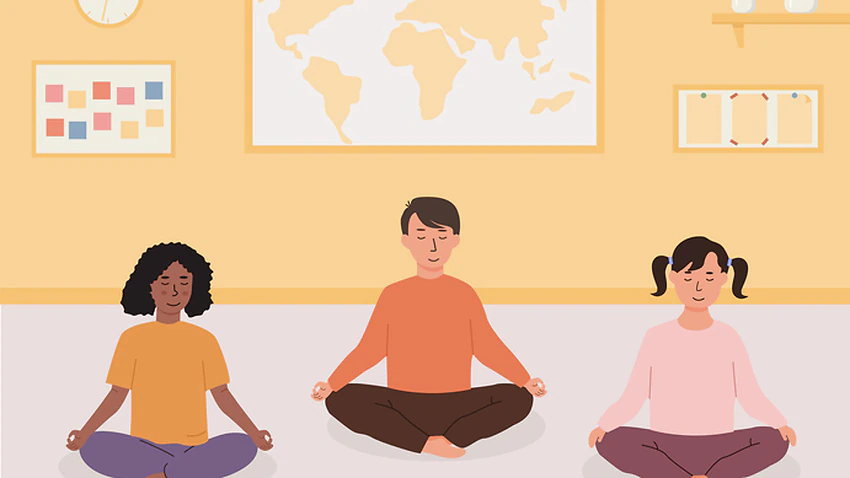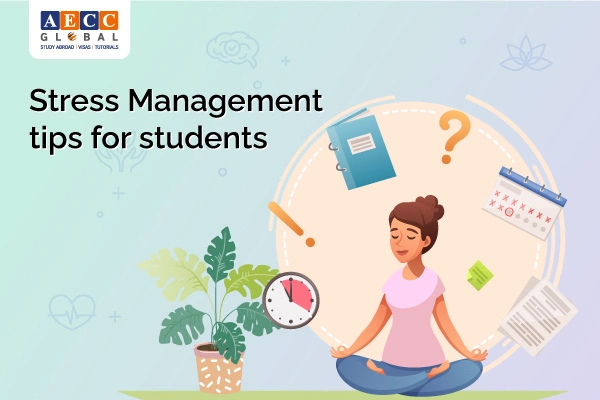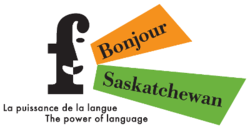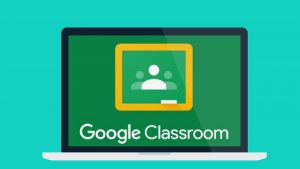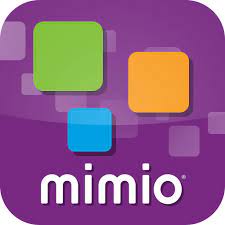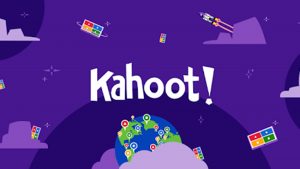Welcome to my blended course prototype for French Language Arts – 2e et 3e année!
 Course Overview
Course Overview
This course will be a blended course prototype that will align itself with French Language Arts class in a Grade 2/Grade 3 French Immersion split class setting and it will be ongoing all year long, with new lessons and activities being uploaded on Google Classroom weekly/bi-weekly depending on the needs of students. The main focus will be literacy development in French (i.e. reading, writing, and speaking) and course content will include pre-recorded lessons in French with some translation in English to ensure all students/families can follow along. Editable worksheets and interactive activities will be available to students to further their learning and help them improve their literacy skills. Furthermore, this course will complement our in-class lessons and will review the concepts we cover in French class which will assist students in improving their overall literacy skills in French. Moreover, this course prototype will also be set up so that if students were absent, missed a concept being taught, or are just needing to review they could access the lessons and course content on their own time and be able to complete the activities from home. Class instruction will take place in person (face to face) during class time in a synchronous setting and the online component provided on Google Classroom will be asynchronous and allow more flexibility to students when completing the different lessons/topics from home.
 Course Rationale
Course Rationale
French Immersion is centered around the goal of ensuring second language learners/students that have enrolled in the program from Kindergarten to Grade 12, will graduate from high school being fully bilingual in English and French; the program also emphasizes that students learn to appreciate the cultural aspects linked to French culture (Government of Saskatchewan, Bonjour Saskatchewan, 2023). All instruction at school from Kindergarten to Grade 2 is solely executed in French and English Language Arts is not introduced as a subject at school until Grade 3. From this point on, instruction is still carried out in French except for English Language Arts and once students move on to high school the required time of instruction in French decreases to accommodate instruction of additional subjects and electives. The end goal is incredibly rewarding and inspiring when you see students in Grade 12 fully capable of communicating in French and being able to carry out a number of tasks in both official languages.
As one can imagine, it can be challenging at times to ensure students receive all their instruction in French (with minimal translation) and that they are fully able to grasp the concepts being taught in class in an additional language. French Immersion Teachers are met with the task of providing instruction to their students that fits their needs and matches their language competencies in French. Students progress at their own pace and it is difficult to plan accordingly to all students’ language competency levels in French; some students pick up the content taught quickly while others require additional time to review and understand different topics. Therefore, an online course component where we can provide a blended learning opportunity for our French Immersion students could be beneficial to students encountering success within the program.
Additionally, Grade 2 and Grade 3 instruction is heavily rooted in literacy development in the areas of reading, writing, and oral competencies in French. Exposure to phonemic awareness, daily modeling (i.e. proper sentence structure, proper pronunciation, reading strategies, decoding skills, etc.), and opportunities to practice new concepts are crucial in the development of an additional language. Moreover, French materials and resources are incredibly difficult to come across for second-language learners in Saskatchewan. Thus, an online component to accompany in-person class instruction allows French Immersion Teachers to set up a learning management system that can include resources, additional interactive activities, learning material, and assessment tools all in one place that all their students can access asynchronously on their own time to review concepts covered in class as well as allow students who are absent the opportunity to review missed concepts to help them become successful in their learning journeys in French Immersion.
Target Student Population and Demographics
This course is geared toward Grade 2 and Grade 3 French Immersion students in a split classroom setting. All students are second language learners and would have started the French Immersion program in Kindergarten and in some cases Grade 1. Level of competency in French varies from student to student and the needs of each child will also vary according to their skill set. Various students have adaptations in place and ROA’s (Record Of Adaptations) to help them find success in the classroom. Diversity is present as is with many classrooms in Regina Public Schools and this should be taken into consideration when planning (i.e. Socio-economic status – access to technology/internet; etc).
There are different expectations and different curriculums used for these two grade levels that also need to be considered:

Grade 2:
- Grade 2 French Immersion uses the Interdisciplinary Curriculum for instruction that is split up into 3 major components that guide teachers’ planning (eight possible authentic questions and Contexts, 49 outcomes, and 358 indicators); this curriculum focuses immensely on literacy development in French.
- By the end of Grade 2, students are expected to be reading at a level 12 (GB+ testing – equivalent to Fountas and Pinnell testing in English).
- All instruction is carried out in French; English Language Arts has not been introduced.
Grade 3:
- The Grade 3 French Immersion curriculum follows a more “traditional” format that divides outcomes and indicators into common subjects (i.e. French Language Arts, English Language Arts, Mathematics, Science, Social Studies, Health, Phys. Ed, etc.).
- By the end of Grade 3, students are expected to be reading at a level 18 (GB+ testing – equivalent to Fountas and Pinnell testing in English).
- All instruction is carried out in French except for English Language Arts; First time that English Language Arts is being taught to students in French Immersion.
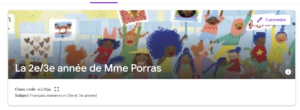 Course Format
Course Format
This course will take on a blended format where there will be instances that class instruction will take place in person (face to face) during class time in a synchronous setting and there will also be an online component provided on Google Classroom that will be asynchronous in nature and allow more flexibility to students when completing the different lessons/topics from home.
As mentioned previously in the “Course Overview” section, this blended course prototype is meant to create opportunities for French second language learners in French Immersion to review and practice different topics taught in French class. This could also be used in instances where students are absent and miss instruction on a given topic in French class and then access the course content later on Google Classroom to review concepts they missed from home or in their spare time.
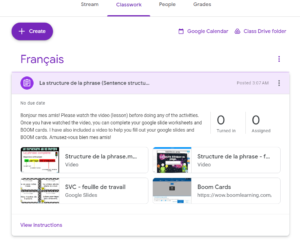 Course Toolset
Course Toolset
For this course, my “Major Platform/Learning Management System” will be Google Classroom.
The following learning material will be available/posted on Google Classroom:
- Powerpoint Presentation of concept
- Pre-recorded lesson of PowerPoint Presentation in French (with English translation included to help all students understand/follow along): will be created with Screencast-O-Matic and Lumi
- Both interactive and paper worksheets/workbooks (to be completed at home or in school if needing extra help/time): created with both Word and Google Slides/Google Docs
- Boom Cards: created on BOOM Cards
- Quizlet activities: created on Quizlet
- Flip video: prompt available on Flip
- Formal evaluation – Quiz (summative assessment) to be
Learning Objectives:
By the end of this course, learners will:
- Have made improvements in reading in French
- Have made improvements in writing in French
- Have broadened their vocabulary in French
- Have improved their comprehension skills in French
- Be able to understand and reproduce (orally and in writing) simple and complex sentences in French
- Understand a variety of French content
- Be able to understand grammar rules and use grammar structure in French
(more precise definition and explanation of these outcomes are mentioned below with a link to the online curriculum in French; I have provided a brief translation/explanation of these outcomes in English)
Grade 2: Les programme d’études de la Saskatchewan – 2e année (2023)
Acquérir les connaissances linguistiques et les référents socioculturels
Résultats d’apprentissage :
AP-AC.1
Utilise :
- les indices visuels;
- la morphologie;
- la syntaxe;
- la segmentation de la phrase;
- les syllabes;
- la graphophonétique;
- la sémantique pour négocier le sens et pour s’exprimer.
AP-AC.2
Utilise des organisateurs graphiques et textuels et des outils de référence pour négocier le sens d’un message et pour s’exprimer.
AP-AC.3
Utilise le vocabulaire de l’interaction et celui de ses activités quotidiennes pour exprimer ses sentiments et ses émotions.
AP-AC.4
Enrichit ses phrases simples déclaratives en démontrant un répertoire croissant de vocabulaire et d’expressions courantes ou idiomatiques.
AP-AC.5
Utilise une représentation visuelle du message pour l’aider dans son processus de négociation de sens et d’expression.
AP-AC.6
Se crée des modèles et des généralisations qu’il ou elle valide et ajuste pour découvrir les règles de la langue.
AP-AC.7
Démontre que les temps des verbes véhiculent une signification d’actions, de pensées et d’évènements dans le temps présent, passé et futur.
AP-AC.9
Distingue et utilise les règles de communication de base, y compris le vous pluriel et le tu singulier.
Grade 3: Les programmes d’études de la Saskatchewan – 3e année
Compréhension écrite
Résultats d’apprentissage :
3.CÉ.1
Dégager le contenu de divers textes :
- le message dans une communication écrite illustrée de cause à effet, de problèmes-solutions et d’énumération;
- les éléments dans une histoire illustrée permettant de répondre aux questions suivantes : Qui? Où? Quand? Quoi? Comment? Pourquoi?;
- le sens global d’un court texte simple sans illustrations.
3.CÉ.2
Utiliser divers moyens (stratégies, conventions linguistiques et entrées en lecture) avant, pendant et après, avec l’aide de l’enseignant ou de l’enseignante, pour :
- se préparer à la période de lecture silencieuse personnelle;
- sélectionner un texte;
- comprendre un message ou un texte :
- faire des prédictions;
- établir des liens entre les éléments du texte et son expérience;
- consulter des ouvrages de référence;
- appliquer ses connaissances des conventions linguistiques;
- réagir à un texte à caractère narratif ou poétique / ludique en faisant part de ses gouts et de ses opinions personnelles;
- réfléchir sur son processus de lecture.
Production écrite
Résultats d’apprentissage :
3.PÉ.1
Rédiger :
- plusieurs phrases pour exprimer ses gouts et ses préférences, ou décrire un environnement ou un évènement;
- un court texte narratif dont les personnages, le lieu, le temps et la situation initiale sont présentés.
3.PÉ.2
Se servir du processus d’écriture, avant, pendant et après, avec l’aide de l’enseignant ou de l’enseignante, pour :
- établir les paramètres de son projet d’écriture, y compris l’intention d’écriture, la structure et les composantes du texte;
- produire un message;
- vérifier le contenu de son message;
- appliquer les conventions linguistiques à son écrit;
- planifier la présentation finale de son projet d’écriture;
- réfléchir à ce qu’il ou elle a produit.
Course Content
This course will be set up to support our French Language Arts class and it will be ongoing throughout the school year. There are 14 different topics that will be split up into 14 individual modules with some wiggle room regarding the time length we take to complete each module. Some modules may take a week or two to complete whereas other concepts that are a bit more complicated to grasp could take a few weeks to complete.
Each module will consist of the following setup:
- PowerPoint Presentation of the new concept
- Pre-recorded lesson of PowerPoint Presentation in French (with English translation included to help all students understand/follow along)
- Both interactive and paper worksheets/workbooks (to be completed at home or in school if needing extra help/time)
- Boom Cards
- Quizlet activities
- Flip video
- Formal evaluation – Quiz (summative assessment) to be completed in class as a whole group.
Here are the 14 modules we will cover in this course:
- La structure de la phrase (Sentence structure)
- La ponctuation (Punctuation)
- Les noms communs (Common Nouns)
- Masculin et féminin (Gender of the word – masculin or feminin)
- Les déterminants (Determiners)
- Singulier ou pluriel (Singular or plural)
- Les noms propres (Proper nouns)
- Les noms personnels (Personal pronouns)
- Être au présent (To be in the present tense)
- Avoir au présent (To have in the present tense)
- Les verbes au présent (Verbs in the present tense)
- Les adjectifs (Adjectives)
- Les prépositions (Prepositions)
- Les adverbes (Adverbs)
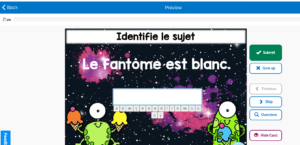 Assessment strategies
Assessment strategies
This course will use both formative and summative assessments throughout the year to monitor student progress:
Formative assessments:
- Worksheets/workbooks
- Boom Cards
- Quizlet activities
- Flip video response (will vary according to the prompt that goes with the topic)
 Summative assessments:
Summative assessments:
- Formal evaluation – Quiz (summative assessment) to be completed in class as a whole group.
Considerations/Common Concerns
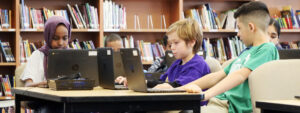 My class next year will be made up of a group of about 28-30 second language learners in Grade 2 and Grade 3 French Immersion. Each student will have their own level of competency in French and will therefore have their own needs. Some students may need to review certain concepts more times than others, while others will be ready to move on to additional activities after in-person lessons in class. In this type of setting, students will be able to work at their own pace and find a balance that works for them and determine their schedule to work from home. However, it is important to consider that in French Immersion – especially in the earlier years of the program – teachers are often translating to facilitate the comprehension of their students as well as broaden their vocabulary in French. Students could potentially encounter language barriers when completing their work at home on Google Classroom. Thus, it is essential that teachers planning to provide this type of blended instruction for a language class need to have certain tools in place – such as online dictionaries, pre-recorded lessons, etc. – to help their students navigate possible language barriers they might come across. It would also be a good idea to set some time aside throughout the school week, where students could come to check in with their teacher and seek guidance if needed in this type of instructional setting.
My class next year will be made up of a group of about 28-30 second language learners in Grade 2 and Grade 3 French Immersion. Each student will have their own level of competency in French and will therefore have their own needs. Some students may need to review certain concepts more times than others, while others will be ready to move on to additional activities after in-person lessons in class. In this type of setting, students will be able to work at their own pace and find a balance that works for them and determine their schedule to work from home. However, it is important to consider that in French Immersion – especially in the earlier years of the program – teachers are often translating to facilitate the comprehension of their students as well as broaden their vocabulary in French. Students could potentially encounter language barriers when completing their work at home on Google Classroom. Thus, it is essential that teachers planning to provide this type of blended instruction for a language class need to have certain tools in place – such as online dictionaries, pre-recorded lessons, etc. – to help their students navigate possible language barriers they might come across. It would also be a good idea to set some time aside throughout the school week, where students could come to check in with their teacher and seek guidance if needed in this type of instructional setting.
More precisely, teachers need to consider that in this type of setting, students will need a tablet, laptop, or computer with internet accessibility to log on to Google Classroom where they can access course material and complete interactive activities. Therefore, ensuring all students have access to the technology required to complete course content will be important seeing as we want equal opportunities for all students and if a household does not have access to a personal device at home, arrangements could be made through the school for them to borrow a school device (i.e. iPad, Chromebook) to use at home or additional time could be provided at school during moments of free time where they could access course content and complete activities.
LINK TO ADDIE TEMPLATE
 Following this week’s lecture, I started reflecting on the topic of accessibility and equity in online and blended courses. Bates mentions that student demographics, accessibility, and differences in how students learn should be considered when choosing media and technology to use with our students (Teaching in a Digital Age). Furthermore, Bates states that “of all the criteria in determining choice of technology, [access] is perhaps the most discriminating” (Teaching in a Digital Age). It is incredibly difficult to ensure students have the same tools at home to access different learning materials online. Educators are not able to confirm if all students have access to the internet, computer, or tablet at home to view online content and we honestly can not demand our students have all these appropriate tools to access online content when we are not fully aware of the restrictions that may prohibit their accessibility. “Another important factor to consider is access for students with disabilities. This [could be for example] providing textual or audio options for deaf and visually impaired students” (Teaching in a Digital Age).
Following this week’s lecture, I started reflecting on the topic of accessibility and equity in online and blended courses. Bates mentions that student demographics, accessibility, and differences in how students learn should be considered when choosing media and technology to use with our students (Teaching in a Digital Age). Furthermore, Bates states that “of all the criteria in determining choice of technology, [access] is perhaps the most discriminating” (Teaching in a Digital Age). It is incredibly difficult to ensure students have the same tools at home to access different learning materials online. Educators are not able to confirm if all students have access to the internet, computer, or tablet at home to view online content and we honestly can not demand our students have all these appropriate tools to access online content when we are not fully aware of the restrictions that may prohibit their accessibility. “Another important factor to consider is access for students with disabilities. This [could be for example] providing textual or audio options for deaf and visually impaired students” (Teaching in a Digital Age).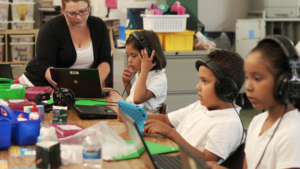 In any learning context, I believe it is imperative that we take the time to get to know our students and thus become aware of their instructional and educational needs. Each student is unique with their own set of needs and preferences to help them achieve success within the classroom. It is important for educators to get to know their students so that they can identify what they need to be able to complete a variety of tasks – especially when we are wanting to integrate technology into their learning repertoire. By talking with families or students we might be able to determine if they require any additional information, tools, or guidance to partake in online and blended classroom initiatives. In these types of interactions, we might come to find out that perhaps some of our families do not have technology at home that their child could access to complete components from an online or blended course; we could then approach the school and explore the possibility of letting some families borrow some technology so their child can partake in an online or blended learning initiative. It is also through these discussions that a teacher might find out their student has a hearing difficulty and could start planning to use subtitles or voice typing programs to include in online lessons so that all students can follow along. Moreover, we also discussed instances where our students’ religious or cultural beliefs might impede them from partaking in online or blended classroom initiatives which prompted many of us to consider what would be the optimal way to proceed; the majority of us agreed that we would not ask families to use any tool that went against their religious or cultural beliefs and that given this type of situation, we would find alternate solutions for students to complete the course work such as providing a paper copy of PowerPoint Presentations and printing off hard copies of activities for these students.
In any learning context, I believe it is imperative that we take the time to get to know our students and thus become aware of their instructional and educational needs. Each student is unique with their own set of needs and preferences to help them achieve success within the classroom. It is important for educators to get to know their students so that they can identify what they need to be able to complete a variety of tasks – especially when we are wanting to integrate technology into their learning repertoire. By talking with families or students we might be able to determine if they require any additional information, tools, or guidance to partake in online and blended classroom initiatives. In these types of interactions, we might come to find out that perhaps some of our families do not have technology at home that their child could access to complete components from an online or blended course; we could then approach the school and explore the possibility of letting some families borrow some technology so their child can partake in an online or blended learning initiative. It is also through these discussions that a teacher might find out their student has a hearing difficulty and could start planning to use subtitles or voice typing programs to include in online lessons so that all students can follow along. Moreover, we also discussed instances where our students’ religious or cultural beliefs might impede them from partaking in online or blended classroom initiatives which prompted many of us to consider what would be the optimal way to proceed; the majority of us agreed that we would not ask families to use any tool that went against their religious or cultural beliefs and that given this type of situation, we would find alternate solutions for students to complete the course work such as providing a paper copy of PowerPoint Presentations and printing off hard copies of activities for these students. I feel that there are indeed some aspects of my blended course that considers accessibility for all my students. As I mentioned in my previous posts, I have included pre-recorded lessons that contain content in French and translations in English for my second-language learners to follow along. Additionally, I have included PowerPoint slides to go along with my pre-recorded lessons for there to be a visual component as well to help students follow along which is essential in any language course. However, there are areas where I can tweak a few things to make it more accessible to students. Following our lecture, I contemplated including some tools to help students with auditory disabilities where I could perhaps add subtitles to my pre-recorded lessons or use some type of “Speech-to-text” program. For example, when uploading videos to YouTube, there is an option to add subtitles in various languages and it will even provide graphs of the most commonly spoken languages in the world; the “Accessibility Toolkit” is a great resource to use for additional information, tools, and tips. Chris Hawkins’ article “The best dictation software in 2023” provides different “Speech-to-text” apps that are available as well. What I plan to do before starting my blended course with my students in the fall is to get to know them and discuss their needs before I start assigning modules. I will provide them with detailed walkthroughs of every program/app we plan to use for our blended course. I plan to also set some time aside with each student individually so we can address their questions or concerns before we start our blended course and I will be contacting families as well as asking them to communicate any needs they might have before we begin. These interactions with students and their families will be a key component to ensuring our blended course runs smoothly and that the students get the most out of this instructional initiative.
I feel that there are indeed some aspects of my blended course that considers accessibility for all my students. As I mentioned in my previous posts, I have included pre-recorded lessons that contain content in French and translations in English for my second-language learners to follow along. Additionally, I have included PowerPoint slides to go along with my pre-recorded lessons for there to be a visual component as well to help students follow along which is essential in any language course. However, there are areas where I can tweak a few things to make it more accessible to students. Following our lecture, I contemplated including some tools to help students with auditory disabilities where I could perhaps add subtitles to my pre-recorded lessons or use some type of “Speech-to-text” program. For example, when uploading videos to YouTube, there is an option to add subtitles in various languages and it will even provide graphs of the most commonly spoken languages in the world; the “Accessibility Toolkit” is a great resource to use for additional information, tools, and tips. Chris Hawkins’ article “The best dictation software in 2023” provides different “Speech-to-text” apps that are available as well. What I plan to do before starting my blended course with my students in the fall is to get to know them and discuss their needs before I start assigning modules. I will provide them with detailed walkthroughs of every program/app we plan to use for our blended course. I plan to also set some time aside with each student individually so we can address their questions or concerns before we start our blended course and I will be contacting families as well as asking them to communicate any needs they might have before we begin. These interactions with students and their families will be a key component to ensuring our blended course runs smoothly and that the students get the most out of this instructional initiative.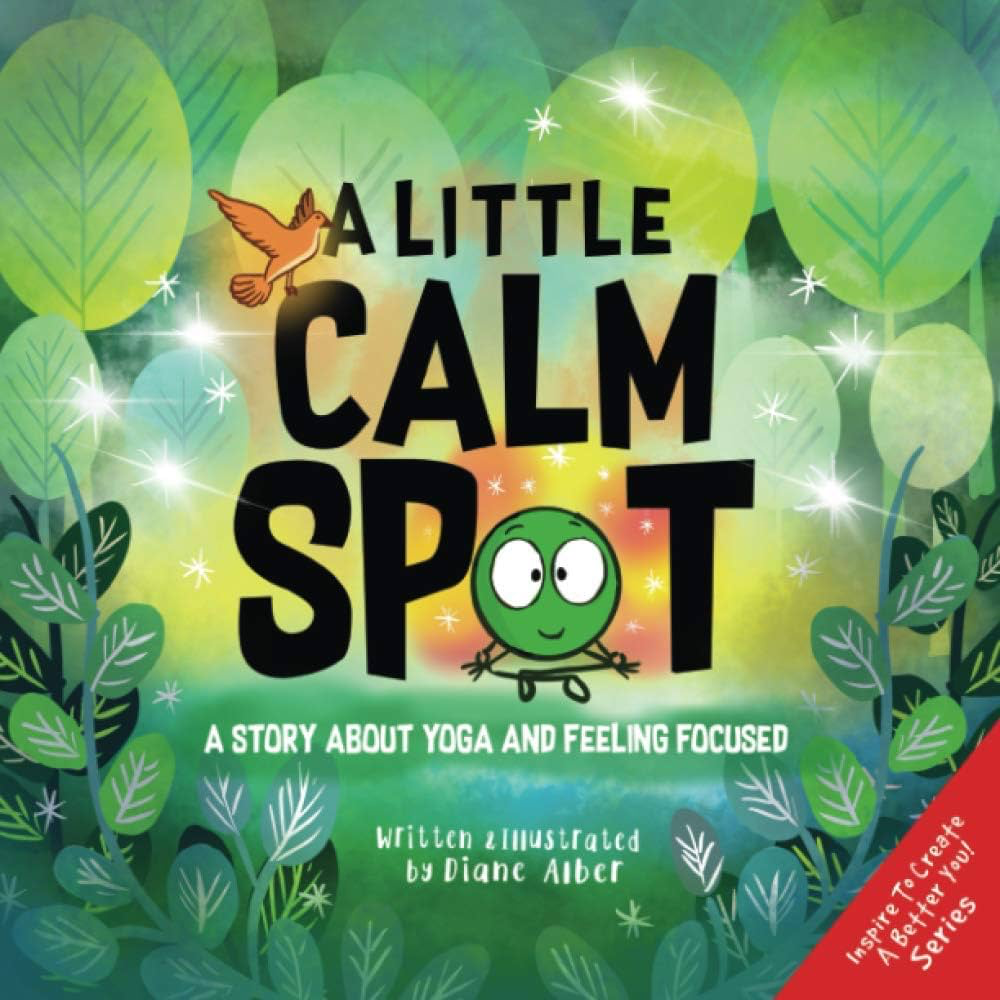
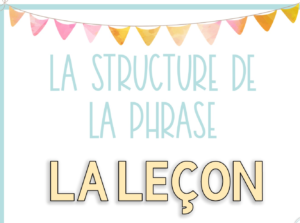 My first module focuses on sentence structure. Seeing as my kiddos will be in Grade 2 and Grade 3, we are focussing on proper sentence composition. We are also concentrating on identifying the subject (le sujet), the verb (le verbe), and the object (le complément) in sentences. Like with most lessons in a French Immersion classroom, exposure to different vocabulary is key to widening our students’ database in French, and we are always translating and providing new vocabulary throughout our lessons when we can.
My first module focuses on sentence structure. Seeing as my kiddos will be in Grade 2 and Grade 3, we are focussing on proper sentence composition. We are also concentrating on identifying the subject (le sujet), the verb (le verbe), and the object (le complément) in sentences. Like with most lessons in a French Immersion classroom, exposure to different vocabulary is key to widening our students’ database in French, and we are always translating and providing new vocabulary throughout our lessons when we can.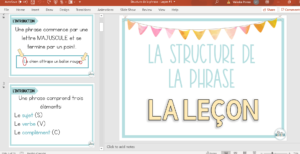 The first thing I proceeded to do when setting up my module, was take the PowerPoint presentation for my lesson and I recorded a video of the slides. This video provided lots of translation throughout its entirety to make sure my students would be able to follow along when accessing it from home. I used
The first thing I proceeded to do when setting up my module, was take the PowerPoint presentation for my lesson and I recorded a video of the slides. This video provided lots of translation throughout its entirety to make sure my students would be able to follow along when accessing it from home. I used 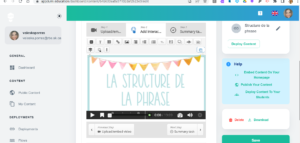 I then went on to take my pre-recorded lesson and make it interactive with
I then went on to take my pre-recorded lesson and make it interactive with  ). I did have to play around with inserting my interactive activities correctly and at precise moments throughout the lesson; I would hope that as I get more comfortable using this tool, I will not need as much time adding the interactive activities correctly.
). I did have to play around with inserting my interactive activities correctly and at precise moments throughout the lesson; I would hope that as I get more comfortable using this tool, I will not need as much time adding the interactive activities correctly. From that point on, I went on to prepare worksheets on Google Slides that students could submit back to me for review and went to select BOOM cards that I would also include in my module. I also prepared a video that walks students through both the Google Slide worksheets and BOOM cards activity where I translate a good chunk of the content for students to help them complete these assignments. Additionally, I provided one extra Quizizz for students who were wanting some extra practice.
From that point on, I went on to prepare worksheets on Google Slides that students could submit back to me for review and went to select BOOM cards that I would also include in my module. I also prepared a video that walks students through both the Google Slide worksheets and BOOM cards activity where I translate a good chunk of the content for students to help them complete these assignments. Additionally, I provided one extra Quizizz for students who were wanting some extra practice. I also created a Flip prompt/activity to go along with this module where I ask students to come up with a few of their own sentences, write them out at home, and then record themselves sharing their sentences with me. I emphasized that when they share each sentence with me, they need to also identify the subject, the verb, and the object in the sentence. This not only helps the kids review what they learned but also provides them with the opportunity to practice speaking in French. I do plan on using the kiddos’ Flip responses as a formative assessment to track their progress.
I also created a Flip prompt/activity to go along with this module where I ask students to come up with a few of their own sentences, write them out at home, and then record themselves sharing their sentences with me. I emphasized that when they share each sentence with me, they need to also identify the subject, the verb, and the object in the sentence. This not only helps the kids review what they learned but also provides them with the opportunity to practice speaking in French. I do plan on using the kiddos’ Flip responses as a formative assessment to track their progress.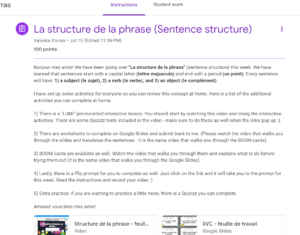 Lastly, once I had all my material prepped and ready to go, I went into my Google Classroom and set up the module for my students. I wrote up a prompt that provided instructions – this was done in English for parents to understand what to do in case they are helping their child. Adding the activities to Google Classroom was quick and efficient; we are able to add different media, videos, and links to our assignments in Google Classroom which makes it easy for the kids to locate all the activities and have access to them in one place.
Lastly, once I had all my material prepped and ready to go, I went into my Google Classroom and set up the module for my students. I wrote up a prompt that provided instructions – this was done in English for parents to understand what to do in case they are helping their child. Adding the activities to Google Classroom was quick and efficient; we are able to add different media, videos, and links to our assignments in Google Classroom which makes it easy for the kids to locate all the activities and have access to them in one place.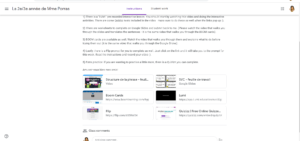 Moreover, I think it is important to consider that younger students will need help gaining access to their Google accounts and log-in information. More precisely, teachers will need to walk their students through step by step all the different activities and components of their blended course before allowing them to have access. In previous years, I have set up times for whole-group instruction to take place when I am introducing a new tool, application, or website. I like to project my computer screen on the whiteboard and have students follow along on either an iPad on Chromebook depending on what is available for them to use. For example, when we started using Kahoots, we practiced how to type in the correct address in the URL bar, insert class code correctly, choose names properly, and submit answers correctly. With any new tool – especially relating to technology – it is essential to walk children through all the steps to access and use it correctly. I anticipate setting a couple of weeks aside where I walk my students through Google Classroom, BOOM cards, Quizlet, Quizizz, and Flip so we can do a couple of practice activities together before starting our modules for our blended course. Additionally, at the beginning of each module, I will be explaining all the activities so the kids know how to access all their resources on Google Classroom and feel confident completing the assignments for me from home.
Moreover, I think it is important to consider that younger students will need help gaining access to their Google accounts and log-in information. More precisely, teachers will need to walk their students through step by step all the different activities and components of their blended course before allowing them to have access. In previous years, I have set up times for whole-group instruction to take place when I am introducing a new tool, application, or website. I like to project my computer screen on the whiteboard and have students follow along on either an iPad on Chromebook depending on what is available for them to use. For example, when we started using Kahoots, we practiced how to type in the correct address in the URL bar, insert class code correctly, choose names properly, and submit answers correctly. With any new tool – especially relating to technology – it is essential to walk children through all the steps to access and use it correctly. I anticipate setting a couple of weeks aside where I walk my students through Google Classroom, BOOM cards, Quizlet, Quizizz, and Flip so we can do a couple of practice activities together before starting our modules for our blended course. Additionally, at the beginning of each module, I will be explaining all the activities so the kids know how to access all their resources on Google Classroom and feel confident completing the assignments for me from home. Course Overview
Course Overview Course Rationale
Course Rationale
 Course Format
Course Format Course Toolset
Course Toolset Summative assessments:
Summative assessments:
